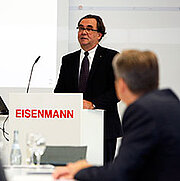A forklift without driver, similar to a self-driving lift carriage – that is the innovative double skid system and its core component, the combined drive, guide and lift power unit. This autonomous transport unit can lift and transport pallets and other carrying devices and weighs just a mere 80 kg, resulting in a very advantageous payload to tare weight ratio. Additionally, it fits completely underneath standard Euro-Pallets due to the fact that each skid with all its energy supply, guidance and drive components fits comfortably into the open space under a Euro-Pallet.
The advantages of this innovation also convinced the enterprise Eisenmann from Böblingen. A pre-production run in 2014 is the first step towards mass production. The initial model is expected to be able to lift pallets of up to 1,000 kg and to move them at a speed of up to 1 m/s. “Over coming years we will see a change-over from the current discontinuous transporters such as forklifts and distribution carriages to novel small vehicles”, explains Professor Karl-Heinz Wehking from the Institute for Transport Technology and Logistics at the University of Stuttgart. “This paradigm shift in intralogistics can be observed worldwide. In German research institutes, a very clear move towards small, intelligent, autonomous devices with decentralized guidance can be noted.” These devices, according to Professor Wehking will in future replace the large, inflexible and expensive centrally guided devices currently used in internal transport solutions.
A good example of such a new device is the double skid system developed at the Institute for Transport Technology and Logistics at the University of Stuttgart under the supervision of Professor Karl-Heinz Wehking. As far back as 2007, Professor Wehking and his collaborators Manuel Weber and Christian Vorwerk at the Institute registered two inventions: in July 2007 an invention entitled “Compact, movable unit for the transport of load carriers, e.g. pallets” by Manuel Weber, and closely linked to this a second invention, registered a month later called “Flexible networks of autonomous, modular and interactively cooperating vehicles” which was however not pursued further. The Technologie-Lizenz-Büro (TLB) GmbH recognized the potential of the invention with the combined drive, guidance and lift system immediately and applied for intellectual property protection in Germany and Europe. The advantages of the double-skid system were convincing: On the one hand, the compact construction, in addition a high degree of mobility thanks to the combined drive, guidance and lift system which is based on an innovative spindle drive. The TLB continues to assist and guide the patenting process of this invention and supports the Institute in its efforts to market it.
In 2009, the Institute commenced the development of two different driverless transport vehicles. In collaboration with the company Götting KG, the transport vehicle KaTe (Kleine autonome Transporteinheit or small autonomous transport unit) for small loads was built. The double-skid system DKS (Doppelkufensystem) on the other hand was developed by the Institute using its own resources and at its own risk. The fact that the Institute applied its own resources brought with it certain advantages in later negotiations which cannot be overestimated, according to Professor Wehking. But very few university institutes have the resources to develop and manufacture prototypes of this quality. For this reason it would be of great assistance to the economically relevant translation of university research to have support programs focused on the development of prototypes. It would then become possible to advance significantly similar market relevant projects in collaboration with the Technologie-Lizenz-Büro (TLB) GmbH.
The prototypes of the two driverless transport vehicles were presented to the public at the convention LogiMat 2012; they generated much interest with industry professionals. The first serious industry inquiries were generated in mid-2012, including from the company Eisenmann. The enterprise expressed an interest in an exclusive worldwide license and a development cooperation with the Institute to get the double-skid system market ready. In July 2013, the University of Stuttgart and Eisenmann entered into a license and development agreement. An outcome that met the needs of both parties, the university as well as the industry partner, was achieved thanks to the many years of industry experience by Professor Wehking, who was also for many years on the board of directors of the TLB, and the professional competence of Dr Hubert Siller, engineer and responsible innovation manager at TLB. “It is one of the largest license agreements ever entered into by the University of Stuttgart”, notes Professor Wehking. “And it is a splendid example of the great collaboration between the university and TLB.” The next step is now the presentation of the pre-production prototype at LogiMat in February 2014 as well as the first practical tests under real-life conditions.

![[Translate to english:] Präsentierte Vorteile und wissenschaftliche Herausforderungen des Doppelkufensystems: Professor Karl-Heinz Wehking vom Institut für Fördertechnik und Logistik der Universität Stuttgart (IFT) bei der Vorstellung des DKS im Böblinger Unternehmen Eisenmann.](/fileadmin/_processed_/d/6/csm_Doppelkufensystem_fdb32589a0.jpg)

